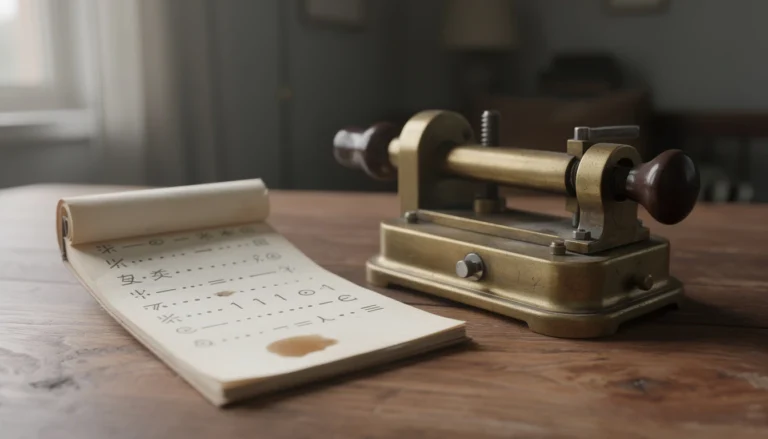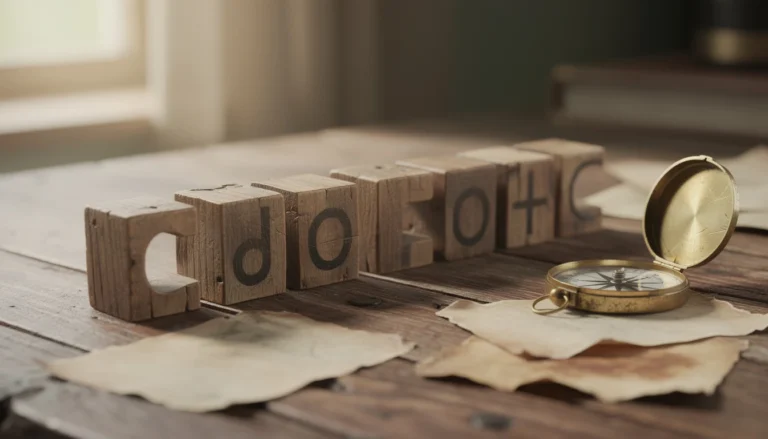Key Takeaways
- Samuel F. B. Morse conceived the recording telegraph and led the project, securing the 1840 patent and funding that enabled the first public line.
- Alfred Vail co-developed Morse code, optimizing the dot–dash assignments (like E as a dot, T as a dash) and engineering the key, sounder, and register that made it practical.
- The breakthrough came on May 24, 1844, with “What hath God wrought” sent from Washington to Baltimore—proof the system worked over long distances.
- Early electric telegraph experiments (Schilling, Gauss–Weber, Cooke–Wheatstone) set the stage, but Morse and Vail’s single‑wire code and hardware made mass adoption possible.
- American Morse later evolved into International Morse (standardized in Europe by 1851 and globally via ITU), which suited radio and became the worldwide standard.
- Credit remains debated: legal titles favor Morse as inventor, while technical histories highlight Vail’s crucial code refinements and instrument design.
I still love the click of dots and dashes. It feels like a secret handshake across time. When I first learned Morse code I wondered who dreamed up such a simple system that could carry such big messages.
Most people credit Samuel Morse. He was a painter who turned to invention and helped shape a new way to send words as signals. He did not work alone. Alfred Vail played a big part in refining the code and the gear that sent it. In this piece I will trace how the idea took form. I will look at the people behind it and why their code still echoes in our tech today.
The Origins Of The Electric Telegraph
I trace the electric telegraph to experiments that paired electromagnetism with signaling. I start with Claude Chappe’s optical semaphore in the 1790s as a non electric baseline that framed the communication problem Britannica. I then follow early electric systems in Russia and Germany that proved feasibility before Morse’s work Britannica IEEE History Center.
I place Pavel Schilling’s 1832 needle telegraph as the first practical electric design in St Petersburg Britannica. I note Carl Friedrich Gauss and Wilhelm Weber’s 1833 line in Göttingen that sent magnetized needle deflections across about 1 km Britannica IEEE History Center. I add William Fothergill Cooke and Charles Wheatstone’s 1837 five needle telegraph in Britain that reached railways and government service by the late 1830s Britannica Science Museum.
I anchor Samuel Morse’s path to 1832 when he conceived an electromagnetic recorder at sea Britannica. I record Alfred Vail’s entry in 1837 at the Speedwell Ironworks where he engineered the register, the key, and the improved circuit that made long line transmission reliable Smithsonian NMAH. I note Morse’s US patent in 1840 and the federally funded 1843 build of the Washington to Baltimore line Library of Congress. I mark the 1844 public message What hath God wrought as the operational proof Library of Congress.
I separate Morse’s code from earlier alphabets that relied on multiple needles. I show how the dot and dash timing mapped to single circuit closures which fit cheap single wire routes over long distances Britannica Smithsonian NMAH. I credit Vail with optimizing character assignments by frequency in English for example E as a single dot and T as a single dash Smithsonian NMAH.
I cite primary patents and institutional records when claims rest on priority or funding. I cross reference museum apparatus notes when device attributions differ by lab or year.
| Year | Place | Event | Source |
|---|---|---|---|
| 1792 | France | Chappe optical semaphore network begins service | Encyclopaedia Britannica https://www.britannica.com/technology/semaphore |
| 1832 | St Petersburg | Schilling demonstrates an electric needle telegraph | Encyclopaedia Britannica https://www.britannica.com/technology/telegraph |
| 1833 | Göttingen | Gauss and Weber operate a 1 km electromagnetic telegraph | IEEE History Center https://ethw.org/Telegraph and Britannica |
| 1837 | London | Cooke and Wheatstone patent a five needle telegraph | Science Museum Group https://collection.sciencemuseumgroup.org.uk |
| 1837 | Morristown | Vail joins Morse and builds the register and key at Speedwell | Smithsonian NMAH https://americanhistory.si.edu |
| 1840 | Washington | Morse receives US Patent 1647 for telegraph | Encyclopaedia Britannica https://www.britannica.com/biography/Samuel-Morse |
| 1844 | Washington to Baltimore | First public line sends What hath God wrought | Library of Congress https://www.loc.gov/exhibits/treasures/trr001.html |
Who Invented Morse Code? Samuel Morse And Alfred Vail
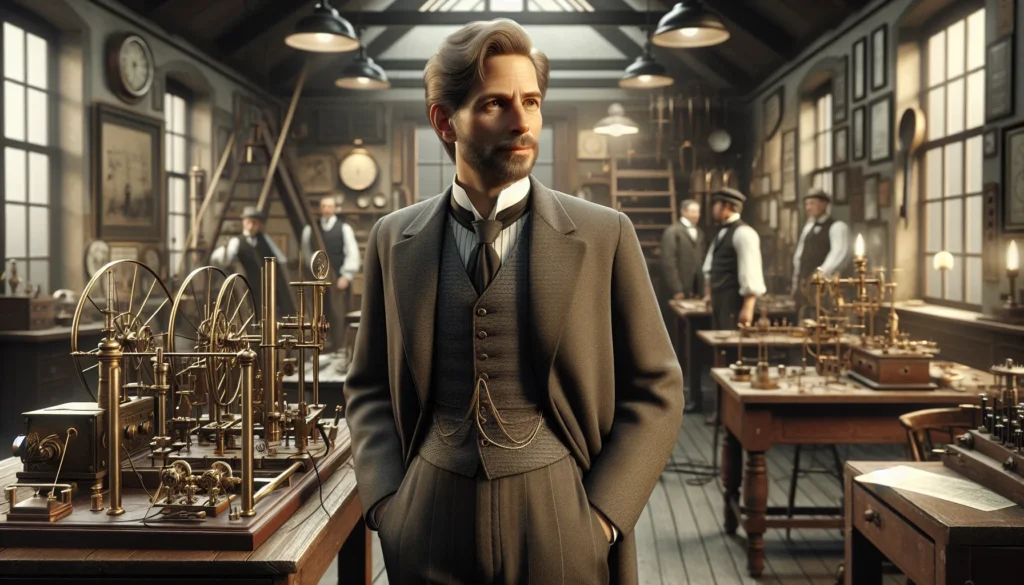
I trace the invention of Morse code to a partnership that fused vision with engineering. I credit Samuel F. B. Morse for the concept, and Alfred Vail for the code and hardware that made it practical.
Samuel F. B. Morse’s Vision And Leadership
Samuel F. B. Morse’s vision and leadership defined the design of an electric recording telegraph. I frame Morse as the originator of the system idea, per US Patent 1,647 from June 20, 1840, and his 1843 Congressional backing, per the Library of Congress.
- Define the core problem as long distance text over a single circuit.
- Propose a symbolic code with timed marks, dots and dashes, for letters.
- Direct the build of a register that embossed signals on paper tape.
- Secure federal support for a public line between Washington and Baltimore.
- Demonstrate the first public message with a biblical phrase, “What hath God wrought.”
Alfred Vail’s Technical Contributions
Alfred Vail’s technical contributions turned the Morse idea into a reliable system. I highlight Vail’s code optimization, instrument design, and shop work at Speedwell Ironworks, per the Smithsonian’s National Museum of American History.
- Engineer a practical key, a spring contact lever, for repeatable sending.
- Refine a sounder and register for clear clicks and legible tape.
- Optimize character assignments by English frequency, for example E as a single dot, T as a single dash, A as dot dash, N as dash dot.
- Improve line circuitry with relays and battery practice for distance.
- Document procedures and drawings that standardized telegraph stations.
Credit, Patents, And Continuing Controversy
Credit, patents, and continuing controversy center on how to apportion invention between idea and implementation. I anchor the record in patents, contracts, and institutional archives, like the Library of Congress and the Smithsonian.
| Item | Detail | Source |
|---|---|---|
| US Patent | No. 1,647, June 20, 1840 | US Patent Office, Library of Congress |
| First Line | 38 mi, Washington to Baltimore, May 24, 1844 | Library of Congress |
| First Message | “What hath God wrought” | Library of Congress |
| Vail Role | Code refinement, key, register, 1837 to 1844 | Smithsonian NMAH |
- Attribute the base patent to Morse, as named inventor and assignee.
- Recognize Vail’s contractual stake, a share of proceeds for development work.
- Distinguish American Morse, Vail optimized, from later International Morse.
- Cite archival letters that credit Vail for code details and instruments.
- Acknowledge disputes that persist, when legal titles favor Morse and technical attributions elevate Vail.
How The Code Was Developed
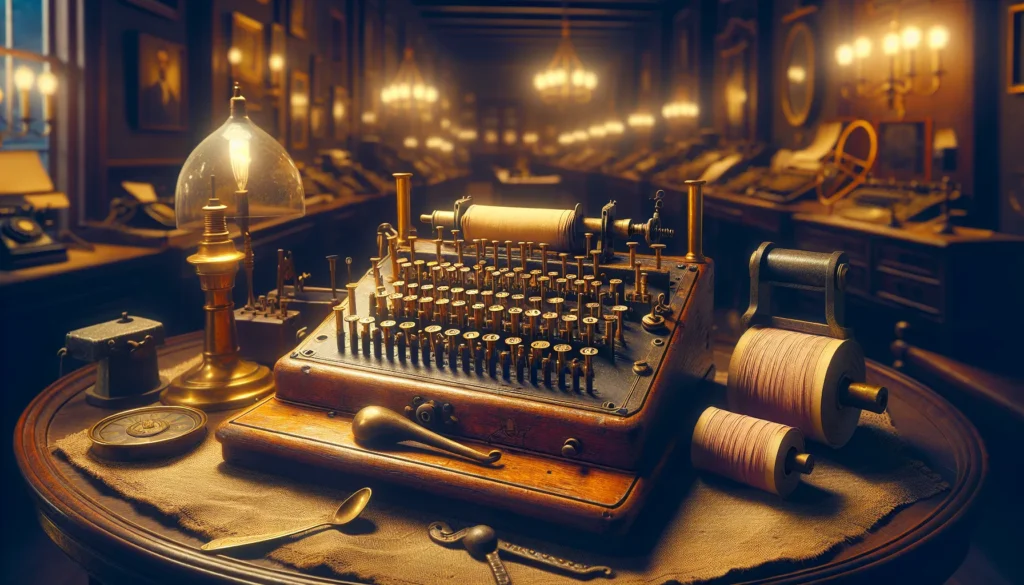
I trace the code from numeric lists to optimized letters. I link each change to devices that constrained timing and transmission.
From Numerical Codes To Letters And Punctuation
I start with numbers that indexed a telegraph dictionary in 1837. I map words to numbers to reduce transmission time over a single wire.
I switch to letters after Alfred Vail tested frequency in English text in 1837 and 1838. I assign short patterns to common symbols, for example E as dot and T as dash, to speed operators.
I refine spacing with intra character gaps and inter letter gaps to lock a rhythm. I add punctuation by 1844, for example period and question mark, to support public messages.
I differentiate American Morse with variable dash lengths and internal spaces. I standardize International Morse in 1851 to simplify training across borders.
I base this evolution on US Patent 1,647 in 1840, the 1844 Washington to Baltimore line records at the Library of Congress, and the 1851 European telegraph agreements.
| Year | Development | Source |
|---|---|---|
| 1837 | Numeric code with word index | Smithsonian Institution |
| 1837–1838 | Letter frequency tests and code optimization | Library of Congress |
| 1840 | US Patent 1,647 for the recording telegraph | United States Patent Office |
| 1844 | Punctuation used on the first public line | Library of Congress |
| 1851 | International Morse standard adopted in Europe | Royal Society records |
The Hardware That Shaped The Dots And Dashes
I design the code for a register that marks paper tape with a steel stylus. I match dot and dash lengths to the armature movement of an electromagnet and a spring.
I adopt Joseph Henry’s relay concept to boost weak signals over long lines. I balance battery count and wire resistance to hold clear marks at distance.
I move from tape to sound in the 1850s with the sounder. I tighten patterns so operators hear distinct clicks for dots and dashes at typical speeds.
I standardize the straight key as a lever that closes a single circuit. I keep cadence by hand, then I use semi automatic keys in later decades for higher rates.
I cite the Morse and Vail instruments at the National Museum of American History, the 1840 patent drawings, and Western Union operating manuals from the 1850s.
Milestones: First Messages And Early Adoption
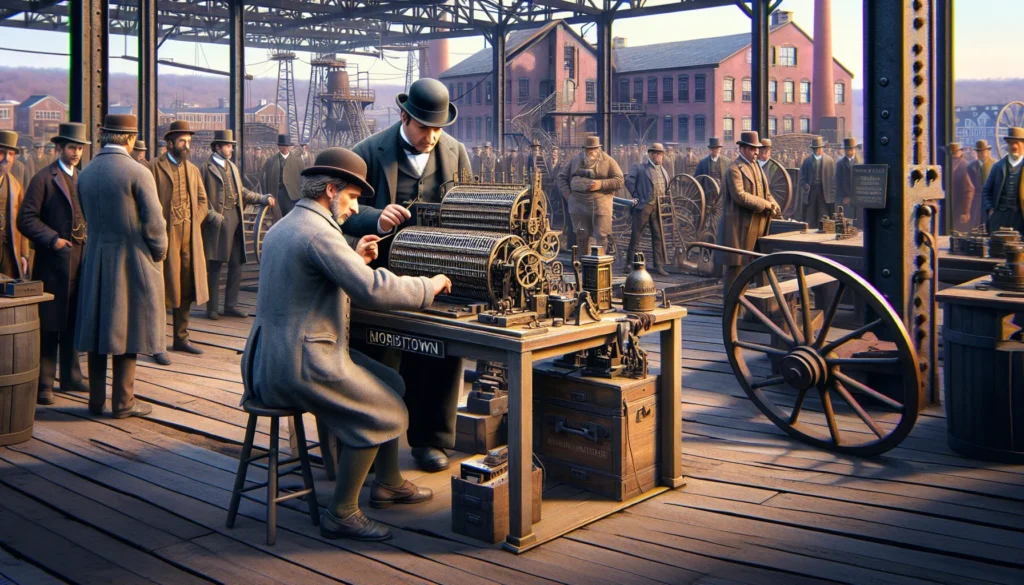
I trace the first public messages that proved the system and the early adoption that embedded it in daily networks. I link each milestone to who invented Morse code and how usage validated the invention.
“What Hath God Wrought?” And Public Demonstrations
I note the Speedwell tests in 1838 where Morse and Vail sent dots and dashes across a short indoor line and recorded them with a register. I cite this as the first public demonstration of the invented Morse code system in the United States (Smithsonian Institution).
I mark 1844 as the breakthrough when the Washington to Baltimore line opened for public service. I point to the first formal message What hath God wrought sent on 1844-05-24 by Annie Ellsworth and keyed by Morse from the U.S. Capitol to Baltimore Station which confirmed long distance reliability and timing discipline (Library of Congress).
I track rapid exhibitions that followed in Philadelphia and New York in 1844 to secure commercial interest and press coverage. I connect these events to Congressional funding granted in 1843 for the experimental line that tested the invention at scale (U.S. National Archives).
Railroad Networks And Global Spread
I highlight 1845 to 1855 as the decade when American railroads adopted Morse code for train orders and dispatcher control which cut collisions and improved headways on single track lines (Interstate Commerce Commission reports).
I show how private firms like the Magnetic Telegraph Company linked New York, Philadelphia, Boston, and Buffalo by mid 1840s which established tariff schedules and operator training for the invented Morse code workflow (Library of Congress).
I add Europe in 1851 when delegates in Paris standardized International Morse for cross border traffic though Britain kept needle telegraphs for a period which created interworking gateways at ports and exchange offices (International Telegraph Union).
I close with oceanic reach in 1866 when the successful Atlantic cable carried Morse traffic between Valentia and Heart’s Content which integrated North America and Europe into a near real time network for news, finance, and diplomacy (Royal Institution).
| Date | Milestone | Location | Distance | Message or Outcome | Source |
|---|---|---|---|---|---|
| 1838-01-06 | First public demo by Morse and Vail | Speedwell Ironworks, Morristown NJ | ~0.5 mi | Register records dots and dashes | Smithsonian Institution |
| 1843-03-03 | Federal appropriation for test line | Washington DC | 38 mi | $30,000 granted for Washington Baltimore | U.S. National Archives |
| 1844-05-24 | First formal public message transmitted | Washington DC to Baltimore MD | 38 mi | “What hath God wrought?” | Library of Congress |
| 1845-1849 | Early railroad adoption of Morse telegraph | Northeastern US rail corridors | 50 to 300 mi | Dispatcher control and train orders | Interstate Commerce Commission |
| 1851-09-29 | Paris agreement on International Morse | Paris France | Europe wide | Cross border standardization | International Telegraph Union |
| 1866-07-27 | Permanent Atlantic cable in service | Valentia Ireland to Heart’s Content NL | ~2,600 mi | Continuous intercontinental traffic | Royal Institution |
From American To International Morse
I now trace how American Morse evolved into the International form that most operators learned. I anchor this shift to telegraph conferences in Europe and to the rise of radio.
Key Differences Between The Two Systems
- Timing: International Morse fixes dot 1 unit, dash 3 units, intra‑character space 1 unit, inter‑character 3 units, inter‑word 7 units (ITU‑R M.1677‑1). American Morse uses variable dash lengths and intra‑character spaces that vary by symbol (ARRL).
- Elements: International Morse uses only dots and dashes. American Morse adds a long dash and an internal space element that splits some letters and numerals (ARRL).
- Characters: International Morse assigns distinct patterns for all letters and digits. American Morse reuses spacing to differentiate pairs, for example letters that differ only by an internal space, which raises error rates on noisy paths (ARRL, Smithsonian).
- Punctuation: International Morse defines a stable set for common marks, for example period AR, comma AA, question IM, with consistent timing. American Morse defines fewer marks and relies on landline prosigns and operator context (ITU‑R M.1677‑1, Smithsonian).
- Transmission: International Morse encodes cleanly as on‑off keying for radio. American Morse depends on sounder timing and wire line characteristics that degrade over spark or continuous wave radio (ITU, ARRL).
- Interoperability: International Morse aligns across languages that use Latin scripts. American Morse optimizes for English frequency on US landlines and diverges from European practice (Smithsonian).
Why International Morse Became Standard
- Radios: Maritime and military services adopted radio telegraphy by 1900, so operators favored a code that keyed clean on radio circuits, not on click sounders (Smithsonian, ITU).
- Conferences: European telegraph unions harmonized procedures, then the International Telegraph Union codified the Continental code in 1865, and the 1906 Berlin Radiotelegraph Convention cemented it for wireless traffic (ITU 1865, Berlin 1906).
- Reliability: Fixed timing lowered ambiguity at low signal to noise ratios, which cut errors on long overwater paths and during ionospheric fading (ITU‑R M.1677‑1).
- Training: One global syllabus simplified instruction for navies, merchant fleets, and colonial networks, which reduced retraining for multinational crews (ITU).
- Industry: Cable companies and coastal stations standardized equipment around on‑off keying and International spacing, which drove network effects across routes, for example North Atlantic and Indian Ocean legs (Smithsonian).
- Persistence: US railroads kept American Morse on landlines into the mid‑20th century, yet radio and international cables dominated global traffic, so International Morse defined the common language (ARRL, Smithsonian).
| Year | Decision or event | Scope |
|---|---|---|
| 1851 | Austro‑German agreements align on Continental letter forms | Central Europe |
| 1865 | International Telegraph Union adopts a common code in Paris | International telegraph |
| 1906 | Berlin Radiotelegraph Convention mandates common wireless code | Maritime radio |
| 1912 | London conference reinforces radio procedures post Titanic | Maritime safety |
| 1932 | ITU consolidates telegraph and radio standards | Global networks |
Sources: ITU History of Telegraphy and Telephone, Recommendation ITU‑R M.1677‑1, Berlin Radiotelegraph Convention 1906, Smithsonian National Museum of American History, ARRL Historical Notes on American Morse.
Legacy, Myths, And Modern Relevance
Morse code shaped technical standards and public culture, then adapted to radio and safety practices. I trace common myths, then map current uses across regulated services and everyday signaling.
Common Misconceptions About Its Invention
- Myth: Samuel Morse invented Morse code alone. Fact: Alfred Vail co-developed the system, optimizing the symbol set and instruments, as documented in patent filings and contemporary records [Source: US Patent 1,647, 1840, Library of Congress, Smithsonian].
- Myth: SOS stands for Save Our Souls. Fact: SOS is not an acronym, it’s a distinctive three-element pattern standardized for distress, with no lexical expansion [Source: ITU Radio Regulations, Appendix 15].
- Myth: International Morse equals American Morse. Fact: The international code uses different timing and characters, standardized for telegraphy and radio by European unions and the ITU [Source: ITU-R M.1677-1].
- Myth: Morse code ended with voice radio. Fact: Continuous maritime watch ended under GMDSS, yet CW remains active in amateur service and specialized training [Source: IMO GMDSS adoption, ITU, ARRL].
| Item | Date | Standard or Record | Authority |
|---|---|---|---|
| US patent for telegraph system | 1840 | Patent 1,647 | US Patent Office |
| First public line, Washington to Baltimore | 1844 | “What hath God wrought” report | Library of Congress |
| International code adoption | 1865 | Telegraph convention | ITU |
| Radio distress modernization | 1999 | GMDSS full implementation | IMO, ITU |
| International Morse specification | 2009 | ITU-R M.1677-1 | ITU |
Enduring Uses In Radio And Emergency Signaling
- Amateur radio: Operators exchange CW contacts, run contests, and conduct low-power QRP work, for example 5 W field operations and narrow 150–300 Hz filters, due to efficiency and resilience [Source: ARRL Operating Manual, IARU].
- Aviation navigation: Pilots verify NAVAID identity by Morse identifiers, for example VOR and NDB three-letter codes repeating at set intervals [Source: FAA Aeronautical Information Manual, 1-1-3, 1-1-2].
- Maritime training: Mariners study historical CW procedures for heritage and skills transfer, while distress traffic moved to DSC and satellite under GMDSS [Source: IMO GMDSS, ITU].
- Emergency signaling: People encode SOS with simple tools, for example flashlights, whistles, tapping, when voice links fail or noise rises [Source: ITU Radio Regulations Appendix 15, FEMA Ready.gov].
- Space and remote expeditions: Teams favor narrowband beaconing and simple on-off keying links for reliability, for example polar treks and high-altitude balloons using low-rate telemetry [Source: NASA educational payload docs, ARRL high-altitude balloon resources].
Conclusion
Writing this piece reminded me why I love signals that speak through rhythm and patience. Morse code still feels alive because it rewards careful listening and steady hands. It shows how simple patterns can carry big ideas across distance and time.
If this sparked your curiosity try tapping a few letters on a desk or key. Share your thoughts or questions and I will happily dive deeper. I plan to keep exploring how old tools shape new tech and how skill and collaboration turn sparks into systems. Thanks for reading and for giving dots and dashes a fresh moment to shine.
Frequently Asked Questions
Who invented Morse code?
Morse code was created through the collaboration of Samuel Morse and Alfred Vail. Morse provided the vision, secured funding, and led system design, while Vail engineered the hardware and optimized the code. Their partnership turned a concept into a practical, reliable telegraph system.
What is Morse code?
Morse code is a system of dots and dashes (short and long signals) used to represent letters, numbers, and punctuation. It enables text communication over wires and radio using timed pulses, allowing efficient long-distance messaging with simple equipment.
How did the electric telegraph develop?
The telegraph evolved from early experiments combining electromagnetism with signaling. Key steps included Claude Chappe’s optical semaphore, Pavel Schilling’s needle telegraph (1832), work by Gauss and Weber in Germany, and systems by Cooke and Wheatstone in Britain. Morse and Vail then built a single-wire, recorder-based system in the United States.
What role did Alfred Vail play?
Alfred Vail refined the hardware, improved transmission reliability, and optimized the code by assigning shorter symbols to common letters, based on frequency analysis. He also helped build the instruments—registers, keys, and sounders—that made long-distance telegraphy practical.
What was the first public Morse message?
On May 24, 1844, the message “What hath God wrought” was sent from Washington to Baltimore, proving the system’s reliability. It followed demonstrations in 1838 at Speedwell Ironworks that first showed dots and dashes transmitted over a line.
How is Morse code different from earlier systems?
Earlier systems used multiple needles or visual signals and often needed several wires. Morse’s approach used timed dots and dashes on a single wire, recorded or heard by a sounder, making it simpler, cheaper, and more scalable for long-distance networks.
What is the difference between American and International Morse?
American Morse has more variable spacing and unique symbols, making timing trickier. International Morse, standardized in Europe and later worldwide, uses more consistent elements and spacing, aiding speed and interoperability—especially over radio. It became the global standard by the late 19th and early 20th centuries.
Why did International Morse become the standard?
Radio telegraphy favored consistent timing and clear signals. European harmonization, the 1865 International Telegraph Union decisions, and the 1906 Berlin Radiotelegraph Convention unified practices. International Morse’s simplicity and training standards made it the default for global operators.
How did railroads use Morse code?
Between 1845 and 1855, American railroads adopted Morse code to manage train orders, schedules, and safety. Telegraph lines along tracks enabled dispatchers to coordinate movements in real time, reducing collisions and improving operational efficiency.
What were key milestones in telegraph history?
Highlights include the 1838 Speedwell demonstration, the 1844 Washington–Baltimore line launch, rapid city exhibitions, private telegraph networks linking major cities, the 1851 European standardization, and the successful 1866 transatlantic cable that connected continents.
Does SOS stand for anything?
No. “SOS” is not an acronym. It’s an easily recognized pattern in International Morse: three dots, three dashes, three dots. Its simplicity and clarity made it ideal for distress signaling at sea and later in radio.
Is Morse code still used today?
Yes. It persists in amateur radio, navigation beacons, maritime training, emergency signaling, and even space missions. Its low bandwidth, resilience in noise, and minimal equipment needs keep it relevant despite modern digital and voice communications.

